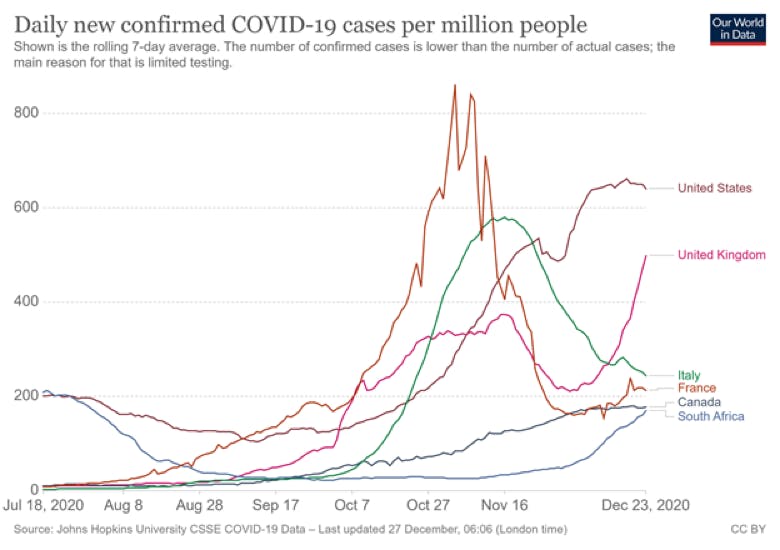Why We Misjudge the Risks of New COVID Strains
How well-calibrated are we on the risk of the new COVID strains, coming from the U.K., South Africa, and elsewhere, and discovered across the U.S.?1 ,2 ,3
Health authorities, various experts, and the media have put the spotlight on concerns over vaccine effectiveness and claimed the strains are likely not going to escape the vaccine. They thus assert there’s no need to ring the alarm.4, 5, 6, 7
For instance, Adm. Brett Giroir, the former White House coronavirus testing czar, gave an interview on December 27 to Fox News Sunday, where he said “It is not any more serious than the normal strains of COVID… we have no evidence to suggest, nor do we believe that the vaccine would not be effective.”8
Yet this proclamation may have come too soon: new research is showing that existing vaccines do indeed appear to be less effective against certain variants of the coronavirus.9 However, because scientists may quickly update the mRNA-based vaccines from Moderna and Pfizer/BioNTech to make them fully effective against these new COVID variants, most experts are confident that we will still be able to contain new variants.10 If the U.S. does indeed achieve herd immunity through mass vaccination by the end of 2021, these new strains may not make much of a difference.11
But there’s another element of these brand-new strains that should make you much more ready to update your risk assessment and change your plans: they’re a lot more infectious. However, the possible impact of their infectiousness has not received nearly enough attention. Such complacency is reminiscent of our “sleepwalking” response to the virus’s emergence last year, in spite of direct advance warning from myself and other experts in behavioral science and risk management.12, 13, 14 That’s why so many in the U.S. and elsewhere have not succeeded in the effort to plan and adapt successfully to this situation.15 Our brains don’t deal well with such threats, making it much more difficult to respond to slow-moving and high-impact train wrecks such as the pandemic itself, or to a much more infectious variant.
Behavioral Science, Democratized
We make 35,000 decisions each day, often in environments that aren’t conducive to making sound choices.
At TDL, we work with organizations in the public and private sectors—from new startups, to governments, to established players like the Gates Foundation—to debias decision-making and create better outcomes for everyone.
Are the New Strains Really More Infectious?
Researchers believe the U.K. strain to be anywhere from 56–70% more contagious than the previous dominant variant,16 meaning each individual person who gets the new strain infects 56-70% more people than the older COVID strain. The new variant quickly came to dominate the old strain of COVID in Southeast England, going from less than 1% of all tested samples at the start of November to over two-thirds by mid-December.17
The South African strain appears even more infectious than the new U.K. strain.18 It came to dominate the country quickly: first found in October, it was responsible for over 80% of all new COVID cases by the end of December.19,20
To corroborate this research, let’s compare new daily COVID cases per million people over December.

Image courtesy of Our World In Data21
The U.K., U.S., Canada, Italy, and France all experienced a major rise in cases in September and October. That’s mainly because colder weather in the Northern Hemisphere drove people to interact indoors, where COVID spreads much more easily.
All these countries imposed various levels of lockdown in late October and early November. That decreased22 or stabilized23 their numbers by late November and early December, with the exception of a Thanksgiving-induced bump in the U.S. that stabilized by mid-December.
The U.K.’s numbers, however, look different. After going from under 250 new cases per day at the start of October, that number went to nearly 400 by mid-November. By early December, the country successfully bent the curve, with new cases dipping below 250 again. However—unlike any of the other countries—it then experienced a sharp uptick from 250 in early December to over 500 new cases daily by the end of December. Given that the U.K. didn’t experience any holiday bumps or changes in government policy, the new strain is the most likely culprit for this deadly surge.
By contrast, South Africa is in the Southern Hemisphere, and it’s summer there from December to February. Given the warm weather, COVID cases would be expected to decrease, not increase. However, South Africa experienced a major surge, from below 30 cases per day in early November to over 180 by the end of December.24 Given the absence of policy changes or other viable explanations, the new COVID variant is almost certainly to blame.
Let’s not make the same mistakes we made in the beginning of the pandemic, making sure to take seriously the real threat of these new strains.25 So what are the implications?
It took the U.K. about two weeks to double its numbers from December 10, at 240 new cases per day, to December 24, with 506 cases. In South Africa, we see a similar pattern of doubling, from 86 cases on December 10 to 182 on December 24. In both cases, it took about two months from the discovery of the variant to the start of the case surge as the new variant took over.26
Given that both variants had likely landed in the U.S. by late November, we can anticipate they have started taking over and could become predominant. Indeed, the CDC projects that the U.K. variant will be dominant in the U.S. by the end of March.27 Moreover, a COVID variant similar to the U.K. one became predominant in Central Ohio in an even shorter time frame, over three weeks from late December into early January, according to a study from Ohio State University study.28
As of March 17, only 21% of the U.S. population has been vaccinated. Given the already-overwhelmed situation within our hospitals, the potential threat of a caseload that doubles every two weeks—as in the U.K. and South Africa—is crystal clear.29,30 Even a 50% increase every two weeks would have a drastic impact.
It’s hard to imagine, but the numbers don’t lie. And a recent study31 suggests that in the U.S., the U.K. strain was responsible for over 3% of all cases by the end of January and, at that point, was doubling every 10 days. The alarm bells should be ringing very loudly.
Why we ignore slow-moving train wrecks
How worried do you feel right now? Is your heartbeat pounding, do you feel a wave of heat, are your palms sweating? Are you thinking about how to change all your plans for the next six months?
Probably not, because our minds aren’t well-adapted to processing the implications of these seemingly abstract numbers. We fall into dangerous judgment errors that scholars in cognitive neuroscience, psychology, and behavioral economics call cognitive biases.32 They result from a combination of our evolutionary makeup and also the particular ways that our brains are wired.33
Such mental blindspots impact all areas of our lives, from health to politics and even our shopping habits.15,34,35,36 Fortunately, recent research has shown effective and pragmatic strategies to defeat these dangerous judgment errors. This starts with recognizing the biases that are most likely to harm us in the pandemic, by causing us to react poorly to slow-moving train wrecks.37
Normalcy Bias
The normalcy bias refers to the fact that our intuitions drive us to feel that the future, at least in the short and medium terms, will function in roughly the same way as the past: normally. As a result, we drastically underestimate both the likelihood of a serious disruption occurring and the impact of one if it does occur.38,39 Indeed, while evaluating the future based on past experience often works, it’s not a good approach for new situations like a novel coronavirus variant.
This bias leads individuals, businesses, and governments to fail to prepare even nearly as well as they should forc potential catastrophes, especially slow-moving disasters such as pandemics. Moreover, in the midst of the event itself, people react much more slowly than they ideally should, getting stuck in the mode of gathering information instead of deciding and acting.
It’s not surprising that going with our gut reactions leads us astray in response to catastrophes that slowly gather steam as they approach. Our threat response causes us, based on our personalities and predispositions, to go into fight-or-flight mode.
The fight response causes us to take immediate action in response to the problem, such as buying toilet paper and guns, as so many did in response to COVID-19. Others fall into the flight response, essentially freezing and ignoring important information—as was the case in many places where social distancing measures were slow to be implemented. It might also mean actual flight, where people try to leave their area for another one that’s perceived as safer, an option that proved popular for those with means.40
Of course, neither of these is the right response for the situation at hand. Fleeing an area or stocking up is fine for the typical disasters that may strike a region, such as a hurricane that might cause major flooding (as happened in Houston in September 2019). It’s not a good fit for the COVID-19 pandemic itself, nor the threat of the new strains.
Hyperbolic Discounting
In the ancient savanna environment, our ancestors had to live in and for the moment, since they couldn’t effectively invest resources to improve their future states (it’s not like they could freeze the meat of the mammoths they killed). Right now, we have many ways of investing in our future lives, such as saving money in banks. Yet our instincts orient us toward short-term rewards at the expense of our long-term futures, a mental blindspot called hyperbolic discounting.41 This cognitive bias causes us to underestimate the eventual impacts of clear trends, such as a more infectious strain of COVID.
That’s why leaders across Europe and the U.S.—in politics, media, and business alike—largely failed to act in a timely manner to address COVID-19 in the first place. Despite extensive evidence showing that outbreaks were growing exponentially, many leaders rejected calls in the early stages of outbreaks to take the course of action shown to be effective in China and other East Asian countries. Officials did not impose shutdowns and social distancing, along with thorough testing, contact tracing, and isolation. The media did not, by and large, ring alarm bells. Following their examples, business leaders largely proceeded with business as usual. Only a few large companies, such as Twitter, Square, and Google, led the way in encouraging employees to work from home, while the English Premier League led the way in canceling sports matches.
The political, media, and business leaders who failed to take action quickly must have felt in their gut that the short-term sacrifice of a shutdown outweighed the long-term benefits of decreasing the impact of the pandemic. It took enormous efforts to convince them otherwise. And despite the clear trend lines from the example of the U.K. and South Africa, we see that in the U.S. and parts of Canada, leaders more or less continue business as usual.
Planning Fallacy
We tend to feel optimistic about our plans: we made them, and therefore the plans must be good, right? We intuitively feel that the future will play out according to these plans. That mental blindspot, the planning fallacy, threatens our ability to prepare effectively for potential problems, and to pivot quickly when they happen.42,43,44 That includes neglecting both major unknown threats, also known as black swans, as well as, more surprisingly, big and obvious threats, known as “gray rhinos.”45 The new strains fall into the latter category, as it was never doubted that the novel coronavirus would mutate (as all viruses do).
Consider how the U.S. and many European countries delayed imposing restrictions in the initial stages of the pandemic, despite clear evidence they were needed. Similarly, in the fall, despite extensive warnings from experts of an upcoming surge, European countries and U.S. states waited until a sharp spike in hospitalizations and deaths to reimpose restrictions.46,47,48
We’re seeing the same happen right now with the new COVID strains. Despite the clear need to act, there’s no action, at least in the U.S., where many states are reducing coronavirus public health restrictions, despite rising cases and deaths.49,50
Attentional Bias
Attentional bias refers to our tendency to pay attention to information that we find most emotionally engaging, and ignore information that we don’t.51,52,53 Given the intense, in-the-moment nature of threats and opportunities in the ancestral savanna, this bias is understandable. Yet in the modern environment, sometimes information that doesn’t feel emotionally salient is actually really important.
In recent days, the headlines in the U.S. focused almost exclusively on the inauguration of the new administration and impeachment trial of Donald Trump, with brief mentions of the 400,000 death toll and slow vaccine rollout. Health officials and scientific experts have focused on discussing the vaccine rollout and how to advance it. There’s almost no discussion of the clear trends of the new strains, and the need to act before it’s too late.
The same problem plagued us early in the pandemic. For example, the fact that the novel coronavirus originated in Wuhan, China, and caused massive sickness and deaths there, didn’t draw much attention as a salient potential threat among Europeans and Americans. It proved too easy to dismiss the importance of the outbreak in Wuhan, due to stereotypical and inaccurate visions of the Chinese heartland as full of backwoods peasants.
In reality, Wuhan is a global metropolis. The largest city in central China, it has over 11 million people and produced over $22.5 billion (USD) in 2018. It has a good healthcare system, strengthened substantially after the SARS pandemic. A major travel hub, Wuhan’s nickname is “the Chicago of China”; it had over 500 international flights per day before the outbreak. If we assume an average of 250 people per plane, that’s 10,000 people a day flying out of Wuhan to the world.
Europeans and Americans, with the exception of a small number of experts, failed to perceive the threat to themselves from the breakdown of Wuhan’s solid healthcare system as it became overwhelmed by COVID-19. They arrogantly assumed this breakdown pointed to the backwardness of China, rather than accurately concluding that any modern medical system could become overwhelmed in the face of the novel coronavirus.
They also failed to recognize the thorough interconnectedness of Wuhan to the rest of the globe. Case in point: the first case of COVID-19 in the U.S. was diagnosed in a traveler from Wuhan in the state of Washington. The first epicenter of COVID-19 in Europe, northern Italy, has particularly close ties to Wuhan due to the robust fashion and garment industry in Milan and other northern Italian cities, which outsources manufacturing to Wuhan.54
Europeans only began paying serious attention to COVID-19 when it began to take root in Italy. Americans, in turn, started to pay attention when COVID-19 surfaced in Washington state.
Do you know who didn’t ignore Wuhan, besides a small number of experts? Those to whom this city felt emotionally salient. Those who understood that Wuhan could be fairly compared to Chicago in the U.S., Manchester in the U.K., or Frankfurt in Germany.
That emotional salience helps explain why many Chinese communities in Europe and America acted quickly and effectively to minimize the impact of COVID-19. For instance, the 50,000 Chinese in Pareto, Italy—a quarter of the city’s residents—went into voluntary lockdown at the end of January. That’s three weeks before the first recorded infection in Italy.55
With their connections to China, the members of these communities could envision what was to come, and spread the word to close their businesses, stay home as much as possible, and wear masks in the rare event that they ventured outside. That helps explain why, according to Renzo Berti, the top state health official for the region, none of the Chinese residents in Pareto got COVID-19 and the town’s infection rate was half of the Italian average, 62 cases per 100,000 people (compared to 115 for the entire country).
Imagine what would have happened if everyone behaved like these communities? Businesses, individuals, and governments acting together could have prevented the enormous death toll and economic devastation from the novel coronavirus. Yet our attentional bias led us astray. The same thing is happening right now with the new strains.
Conclusion
While this evidence may feel unreal, keep in mind that’s simply our cognitive biases pushing us to feel like that, just like they did early in the pandemic. We’re miscalibrated on the risks of these new strains, and only by taking into account our mental blindspots can we correct for them and take the steps needed to prepare effectively for the high likelihood of a major surge in spring 2021.
References
- Suarez Sang, L. I. (2020, December 27). Canada, Japan among nations reporting infections with fast-spreading UK coronavirus strain. Fox News. https://www.foxnews.com/world/canada-japan-uk-coronavirus-strain-new-cases
- Fischer, L. (2020, November 11). The real danger posed by coronavirus-infected mink. Scientific American. https://www.scientificamerican.com/article/the-real-danger-posed-by-coronavirus-infected-mink/
- Willetts, M. (2021, January 7). New, more contagious COVID strain has spread to at least 8 states, officials say. Miami Herald. https://www.miamiherald.com/news/coronavirus/article248350185.html
- Blitzer, R. (2020, December 27). Adm. Giroir: Coronavirus vaccines will be ‘effective’ against new strain. Fox News. https://www.foxnews.com/politics/asst-hhs-sec-giroir-coronavirus-vaccines-effective-against-new-strain
- Elkind, E. (2020, December 23). Dr. Anthony Fauci says COVID vaccine is key to returning to “some form of normality”. CBS News. https://www.cbsnews.com/news/anthony-fauci-cbsn-interview-watch-live-stream-today-2020-12-23/
- Elkind, E. (2020, December 26). “Good reason” to think vaccines will be effective against mutated COVID-19 strains, doctor says. CBS News. https://www.cbsnews.com/news/covid-vaccines-effective-mutated-strains-doctor/
- Weintraub, K. (2021, January 9).New coronavirus variants aren’t cause for alarm yet, but mutations could make COVID-19 harder to fight, experts say. USA TODAY. https://www.usatoday.com/story/news/health/2021/01/09/new-coronavirus-strains-variants-not-yet-cause-for-more-covid-vaccine-concerns-experts-say/6575267002/
- Budryk, Z. (2020, December 27). White House testing Czar: More infectious COVID strain is no more dangerous. TheHill. https://thehill.com/homenews/sunday-talk-shows/531738-white-house-testing-czar-more-infectious-covid-strain-is-no-more
- Yilek, C. (2021, February 17). Third shot may be needed to combat new coronavirus variants, Bill Gates says. CBS News. https://www.cbsnews.com/news/covid-vaccine-variants-third-shot-bill-gates/
- Parsons, L. (2020, December 23).COVID-19 vaccine developers respond to new strain. PMLive. https://www.pmlive.com/pharma_news/covid-19_vaccine_developers_respond_to_new_strain_1360492
- Powell, A. (2020, December 10). Anthony Fauci offers a timeline for ending COVID-19 pandemic. Harvard Gazette. https://news.harvard.edu/gazette/story/2020/12/anthony-fauci-offers-a-timeline-for-ending-covid-19-pandemic/
- Genomic Surveillance for SARS-CoV-2 Variants. (2021, February 2). Centers for Disease Control and Prevention. https://www.cdc.gov/coronavirus/2019-ncov/cases-updates/variant-surveillance.html?CDC_AA_refVal=https%3A%2F%2Fwww.cdc.gov%2Fcoronavirus%2F2019-ncov%2Fmore%2Fscientific-brief-emerging-variant.html
- Entrepreneurs’ Organization. (2020, March 13). One huge mistake leaders make in preparing for the coronavirus pandemic. Inc.com. https://www.inc.com/entrepreneurs-organization/one-huge-mistake-leaders-make-in-preparing-for-coronavirus-pandemic.html
- Sequoia. (2020, March 6). Coronavirus: The Black swan of 2020. Medium. https://medium.com/sequoia-capital/coronavirus-the-black-swan-of-2020-7c72bdeb9753
- Tsipursky, G. (n.d.). Adapt and plan. Disaster Avoidance Experts. https://disasteravoidanceexperts.com/adapt/
- Porterfield, C. (2020, December 24). New Coronavirus Strain Is 56% More Infectious, Scientists Estimate. Forbes. https://www.forbes.com/sites/carlieporterfield/2020/12/24/new-coronavirus-strain-is-56-more-infectious-scientists-estimate/?sh=3dd30ccf297c
- Gallagher, J. (2020, December 20). New coronavirus variant: What do we know? BBC News. https://www.bbc.com/news/health-55388846
- AFP. (2020, December 23). UK says South African strain even more infectious than its own new variant. The Times of Israel. https://www.timesofisrael.com/uk-says-south-african-strain-even-more-infectious-than-its-own-new-variant/
- Wei-Haas, M. (2020, December 24). Why new coronavirus variants ‘suddenly arose’ in the U.K. and South Africa. National Geographic. https://www.nationalgeographic.com/science/article/why-new-coronavirus-variants-suddenly-arose-in-uk-and-south-africa
- Explainer: The new coronavirus variant in South Africa – Are concerns justified?. (2020, December 25). Reuters. https://www.reuters.com/article/us-health-coronavirus-safrica-variant-ex/explainer-the-new-coronavirus-variant-in-south-africa-are-concerns-justified-idUSKBN28Z0DR
- Daily new confirmed COVID-19 cases per million people. (n.d.) Our World in Data. https://ourworldindata.org/coronavirus-data-explorer?zoomToSelection=true&time=2020-08-16..2020-12-24&country=GBR~USA~ZAF~ITA~FRA®ion=World&casesMetric=true&interval=smoothed&hideControls=true&perCapita=true&smoothing=7&pickerMetric=location&pickerSort=asc
- Amaro, S. (2020, November 17). Europe’s second wave shows signs of slowing after new lockdowns. CNBC. https://www.cnbc.com/2020/11/17/covid-19-infections-in-europe-appear-to-slow-down-after-new-lockdowns.html
- COVID-19: Canada’s largest city moves back into lockdown. (2020, November 21). BBC News. https://www.bbc.com/news/world-us-canada-55024674
- Climate- South Africa. (n.d.). Climates to Travel. https://www.climatestotravel.com/climate/south-africa
- Zvi. (2020, December 24). Covid 12/24: We’re F***ed, It’s Over. Less Wrong. https://www.lesswrong.com/posts/CHtwDXy63BsLkQx4n/covid-12-24-we-re-f-ed-it-s-over?fbclid=IwAR1blhWGf3tzy-drv8him1I7m3MgpA5Txv8Q40mKjKcryez9Bb6lNT489hA
- Cohen, E. (2020, December 22). Researchers think ‘hundreds’ of people in US could have new UK coronavirus strain. CNN. https://edition.cnn.com/2020/12/22/health/uk-coronavirus-variant-surveillance/index.html
- BBC. (2021, March 2). COVID-19 variants pose ‘real threat’ to vaccine progress, CDC warns. BBC News. https://www.bbc.com/news/world-us-canada-56247656
- Researchers discover new variant of COVID-19 virus in Columbus, Ohio. (2021, January 13). The Ohio State University Wexner Medical Center. https://wexnermedical.osu.edu/mediaroom/pressreleaselisting/new-sars-cov2-variant
- Kaufman, E., Grayer, A., Murray, S., & Kane, A. (2020, December 28). US officials promised 20 million vaccinated against coronavirus by the end of the year. It’s going slower than that. CNN. https://edition.cnn.com/2020/12/23/health/vaccine-rollout-slow-data-lags/index.html
- Meyer, R., & Madrigal, A. (2020, December 5). The U.S. has passed the hospital breaking point. The Atlantic. https://www.theatlantic.com/health/archive/2020/12/the-worst-case-scenario-is-happening-hospitals-are-overwhelmed/617301/
- Genomic epidemiology identifies emergence and rapid transmission of SARS-Cov-2 B.1.1.7 in the United States. (2021, February 7). medRxiv. https://www.medrxiv.org/content/10.1101/2021.02.06.21251159v1
- Tversky, A., & Kahneman, D.(1974, September 27).Judgment under uncertainty: Heuristics and biases. Science. https://science.sciencemag.org/content/185/4157/1124
- Haselton, M., Nettle, D., Murray, D. (2015, November 18).The evolution of cognitive bias. Wiley Online Library. https://onlinelibrary.wiley.com/doi/full/10.1002/9781119125563.evpsych241
- Tsipursky, G. (2021, February 17). The Blindspots. Disaster Avoidance Experts. https://disasteravoidanceexperts.com/blindspots/
- Tsipursky, G. & Ward, T. (2020, May 29). Pro truth: A practical plan for putting truth back into politics. Books. Amazon.com. https://www.amazon.com/Pro-Truth-Practical-Putting-Politics/dp/1789043999
- Tsipursky, G. (2020, August 9). New Survey Reveals What Really Drives You to Buy What You Buy. Top10. https://www.top10.com/blog/what-really-drives-you-to-buy-what-you-buy
- Tsipursky, G. (n.d.). Never Go With Your Gut: How Pioneering Leaders Make the Best Decisions and Avoid Business Disasters. Disaster Avoidance Experts. https://disasteravoidanceexperts.com/nevergut/
- Omer, H., & Alon, N. (1944, April). The continuity principle: A unified approach to disaster and trauma. American Journal of Community Psychology. https://link.springer.com/article/10.1007/BF02506866
- Tsipursky, G.(2020, January 21). How normalcy bias led Boeing to crash into disaster. Disaster Avoidance Experts. https://disasteravoidanceexperts.com/how-normalcy-bias-led-boeing-to-crash-into-disaster/
- Gordon, A., & Kazakina, K. (2020, March 11). New Yorkers Flee to Hamptons, Hudson Valley to Escape Virus. Bloomberg. https://www.bloomberg.com/news/articles/2020-03-11/new-yorkers-flee-to-hamptons-hudson-valley-to-escape-virus
- Ainslie, G., & Haslam, N. (1992). Hyperbolic discounting. APA PsycNet. https://psycnet.apa.org/record/1993-97149-003
- Buehler, R.,Griffin, D., & Peetz, J.(2010, June 30). The planning fallacy: Cognitive, motivational, and social origins. ScienceDirect. https://www.sciencedirect.com/science/article/pii/S0065260110430014
- Tsipursky, G.(2019, October 27). Are You Falling for the Myth of “Failing to Plan is Planning to Fail”?. Disaster Avoidance Experts. https://disasteravoidanceexperts.com/are-you-falling-for-the-myth-of-failing-to-plan-is-planning-to-fail/
- Tsipursky, G.(2020, September 22). How to Do a Strategic Pivot to Address COVID. Disaster Avoidance Experts. https://disasteravoidanceexperts.com/how-to-do-a-strategic-pivot-to-address-covid/
- Wucker, M. (2016, April). THE GRAY RHINO: How to Recognize and Act on the Obvious Dangers We Ignore. Wucker. https://www.wucker.com/writing/the-gray-rhino/
- Calfas, J., Armour, S., & Coles, I.(2020, March 23). Countries Roll Out Restrictions to Curb Coronavirus. WSJ. https://www.wsj.com/articles/countries-roll-out-restrictions-to-curb-coronavirus-11584954209
- Time To Prepare For Fall’s Anticipated ‘Surge 2.0,’ Experts Warn. (2020, September 8). KHN. https://khn.org/morning-breakout/time-to-prepare-for-falls-anticipated-surge-2-0-experts-warn/
- Bishop, K. & Feuer,W. (2020, November 4). France, Germany and England impose new lockdowns as pandemic fatigue seeps in across Europe and Covid cases soar. CNBC. https://www.cnbc.com/2020/11/04/coronavirus-france-germany-and-the-uk-impose-new-lockdown-orders-as-pandemic-fatigue-seeps-in-across-europe-and-cases-soar.html
- Turley, J. (2021, January 15). North Dakota’s statewide mask mandate will expire next week, Burgum says. Grand Forks Herald. https://www.grandforksherald.com/newsmd/coronavirus/6842585-North-Dakotas-statewide-mask-mandate-will-expire-next-week-Burgum-says
- Coronavirus fatalities rising in two-thirds of states. (2021, January 19). The Blade. https://www.toledoblade.com/news/nation/2021/01/18/virus-fatalities-rising-in-two-thirds-of-states/stories/20210119037
- McNally, R. (2018, May 21). Attentional bias for threat: Crisis or opportunity?. ScienceDirect. https://www.sciencedirect.com/science/article/abs/pii/S0272735817304014
- MacLeod, C., Rutherford, E., Campbell, L., Ebsworthy, G., & Holker, L. (2002). Selective attention and emotional vulnerability: Assessing the causal basis of their association through the experimental manipulation of attentional bias. Journal of Abnormal Psychology, 111(1), 107–123. https://doi.org/10.1037/0021-843X.111.1.107
- Bar-Haim, Y., Lamy, D., Pergamin, L., Bakermans-Kranenburg, M. J., & van IJzendoorn, M. H. (2007). Threat-related attentional bias in anxious and nonanxious individuals: A meta-analytic study. Psychological Bulletin, 133(1), 1–24. https://doi.org/10.1037/0033-2909.133.1.1
- Northern Italy & Wuhan: Partners for better or worse. (2020, March 17). Rebellion Research. https://blog.rebellionresearch.com/blog/northern-italy-wuhan-partners-for-better-or-worse
- Ognibene, S. (2020, April 1)From zero to hero: Italy’s Chinese help beat coronavirus. Reuters. https://www.reuters.com/article/us-health-coronavirus-italy-chinese/from-zero-to-hero-italys-chinese-help-beat-coronavirus-idUSKBN21I3I8
About the Author
Gleb Tsipursky
Dr. Gleb Tsipursky is a behavioral economist, cognitive neuroscientist, and a bestselling author of several books on decision-making and cognitive biases. His newest book is Pro Truth: A Pragmatic Plan to Put Truth Back Into Politics (Changemakers Book, 2020). Dr. Tsipursky is on a mission to protect people from dangerous judgment errors through his cutting-edge expertise in disaster avoidance, decision making, social and emotional intelligence, and risk management. He founded Disaster Avoidance Experts, a behavioral economics consulting firm that empowers leaders and organizations to avoid business disasters. His thought-leadership has been featured in over 500 articles that he has published as well as 450 interviews he has given to popular venues such as CBS News, Scientific American, Psychology Today, and Fast Company, among others. Dr. Tsipursky earned his PhD in the History of Behavioral Science at the University of North Carolina at Chapel Hill, his M.A. at Harvard University, and his B.A. at New York University.





